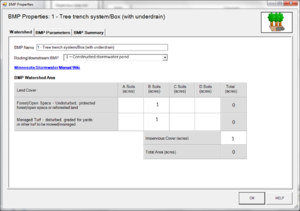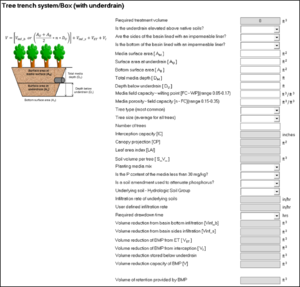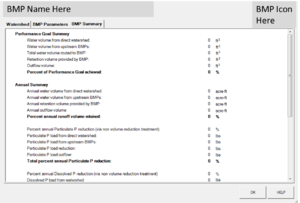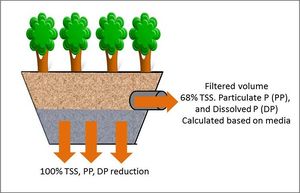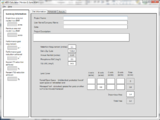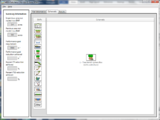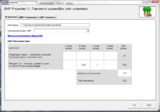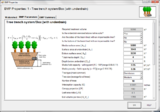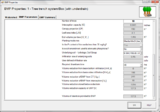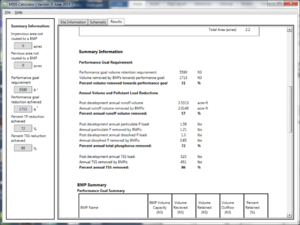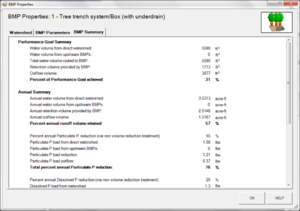
Difference between revisions of "Requirements, recommendations and information for using trees with an underdrain as a BMP in the MIDS calculator"
| Line 33: | Line 33: | ||
**Bottom surface area (A<sub>B</sub>): This is the surface area at the bottom of the media within the BMP. Therefore, this is the area at the surface of the underlying soil. The user inputs this value in square feet. For a tree trench system this is the cumulative area for all similar trees in the system. Similar trees are trees of the same type (deciduous or coniferous) and size (large, medium, or small tree). See [[Plant lists for trees]] for more information. | **Bottom surface area (A<sub>B</sub>): This is the surface area at the bottom of the media within the BMP. Therefore, this is the area at the surface of the underlying soil. The user inputs this value in square feet. For a tree trench system this is the cumulative area for all similar trees in the system. Similar trees are trees of the same type (deciduous or coniferous) and size (large, medium, or small tree). See [[Plant lists for trees]] for more information. | ||
**Media depth (D<sub>M</sub>): This is the media depth between the media surface and the native soils (i.e. thickness of the engineered media). Units are in feet. | **Media depth (D<sub>M</sub>): This is the media depth between the media surface and the native soils (i.e. thickness of the engineered media). Units are in feet. | ||
| + | **'''Total media and soil depth available for tree rooting:''' This is the depth of engineered media and the underlying soil into which tree roots can extend. | ||
**Depth below underdrain (D<sub>U</sub>): This is the depth of the media between the underdrain invert and the native soils. ''If the response to Is the underdrain elevated above native soils?'' is set to NO, then this cell will become inactive and populated with a 0. The user inputs this value in feet. | **Depth below underdrain (D<sub>U</sub>): This is the depth of the media between the underdrain invert and the native soils. ''If the response to Is the underdrain elevated above native soils?'' is set to NO, then this cell will become inactive and populated with a 0. The user inputs this value in feet. | ||
**Media field capacity minus wilting point (FC - WP): This is the amount of water between [[Glossary#F|field capacity]] and the [[Glossary#P|permanent wilting point]] stored in the media. This is water often considered to be available for uptake by plants. If multiple types of media are used in the BMP, this value should be an average of the media installed above the [[Glossary#U|underdrain]]. Values for field capacity and wilting point based on soil type can be found [[Soil water storage properties|here]]. The user inputs this value in cubic feet of water per cubic feet of media. | **Media field capacity minus wilting point (FC - WP): This is the amount of water between [[Glossary#F|field capacity]] and the [[Glossary#P|permanent wilting point]] stored in the media. This is water often considered to be available for uptake by plants. If multiple types of media are used in the BMP, this value should be an average of the media installed above the [[Glossary#U|underdrain]]. Values for field capacity and wilting point based on soil type can be found [[Soil water storage properties|here]]. The user inputs this value in cubic feet of water per cubic feet of media. | ||
Revision as of 18:35, 14 May 2021
For a tree trench system/box with an underdrain at the bottom, most of the stormwater captured by the BMP is lost to the underdrain. However, some stormwater infiltrates through the basin bottom and sidewalls if these do not have an impermeable liner. Evapotranspiration (ET) and interception also occur from the trees planted in the system. For a tree trench/box system with an elevated underdrain, in addition to volume losses through the sidewalls and through evapotranspiration and interception, a portion of the water stored in the media between the underdrain and the native soils is infiltrated. In a tree trench/box BMP with an underdrain, all pollutants in infiltrated water are removed, while pollutants are removed through filtration for the water that flows through an underdrain. All pollutants in water lost to ET and interception are removed.
The user should be aware of the difference between a tree trench system and a tree box.
- Tree trench system is a BMP that includes multiple trees. This BMP is commonly used in areas where pavement overlies the trench system. Runoff from the impermeable surface or through a permeable pavement surface is delivered underground to the underlying media in which the trees are planted. This Manual includes case studies and a discussion of types of tree BMPs.
- Tree box (also called soil box) typically includes a single tree. They are typically proprietary products or are included in bioretention BMPs. If a tree is included in a bioretention BMP, we recommend using the bioretention BMP in the MIDS calculator instead of this BMP.
Contents
- 1 Version 4 changes
- 2 MIDS calculator user inputs for Tree trench system/box
- 3 Model input requirements and recommendations
- 4 Methodology
- 5 Assumptions for tree trench system/box (with underdrain)
- 6 Example application in the MIDS calculator (Version 2)
- 7 Requirements
- 8 Recommendations
- 9 Information
- 10 Links to MIDS pages
- 11 Related pages
Version 4 changes
- The question Is a soil amendment used to attenuate phosphorus? was changed to Do you have a properly designed phosphorus treatment layer or area in your system (e.g. iron enhanced layer)?. Currently, the only option for incorporating an amendment to retain phosphorus is to install a treatment layer below the bioretention media. This typically is a layer containing 5-8 percent iron (link here for more information on iron-enhanced systems). Research is currently being done to determine if amendments can be incorporated directly into the bioretention media.
- When an amendment is added to the practice, the particulate phosphorus removal was changed from 0 to 40 percent. This was error in previous versions of the calculator.
- Added the following question: Total media and soil depth available for tree rooting. This was done to allow trees to extend roots below the engineered media layer. This increases the potential soil volume available to trees, thus potentially allowing more trees to be incorporated into the design.
MIDS calculator user inputs for Tree trench system/box
For Tree trench system/tree box with an underdrain BMPs, the user must input the following parameters to calculate the volume and pollutant load reductions associated with the BMP.
- Watershed tab
- BMP Name: this cell is auto-filled but can be changed by the user.
- Routing/downstream BMP: if this BMP is part of a treatment train and water is being routed from this BMP to another BMP, the user selects the name of the BMP from the dropdown box to which water is being routed. All water must be routed to a single downstream BMP. Note that the user must include the BMP receiving the routed water in the Schematic or the BMP will not appear in the dropdown box.
- BMP Watershed Area: BMP watershed areas are the areas draining directly to the BMP. Values can be added for four soil types (Hydrologic Soil Groups (HSG) A, B, C, D) and for three Land Cover types (Forest/Open Space, Managed Turf and impervious). The surface area of the BMP should be included as a managed turf land cover under the hydrologic soils group of the native soils located under the BMP. Units are in acres.
- BMP Parameters tab
- Is the underdrain elevated above native soils?: This is a YES/NO question. Answering YES means the underdrain is elevated within the media. This creates storage capacity between the underdrain and the native soils. Answering NO means that the underdrain is not elevated within the media and is directly above the native soils with no storage capacity below the underdrain.
- Are the sides of the basin lined with an impermeable liner?: This is a YES/NO question. Answering YES means the sides of the basin are lined, preventing water from infiltrating into the native soils. Answering NO means the sides are not lined and infiltration is allowed through the side of the basin into the native soils.
- Is the bottom of the basin lined with an impermeable liner?: This is a YES/NO question. Answering YES means the bottom of the basin is lined, preventing water from infiltrating into the native soils. Answering NO means the bottom is not lined and infiltration is allowed through the bottom of the basin into the native soils.
- Media surface area (AM): This is the surface area at the surface of the engineered media. The user inputs this value in square feet. For a tree trench system this is the cumulative area for all similar trees in the system. Similar trees are trees of the same type (deciduous or coniferous) and size (large, medium, or small tree). See Plant lists for trees for more information.
- Surface area at underdrain (AU): This is the surface area of the BMP at the invert elevation of the underdrain. If the response to Is the underdrain elevated above native soils? is set to “No” then this cell will become inactive and populated with the Bottom surface area value. The user inputs this value in square feet.
- Bottom surface area (AB): This is the surface area at the bottom of the media within the BMP. Therefore, this is the area at the surface of the underlying soil. The user inputs this value in square feet. For a tree trench system this is the cumulative area for all similar trees in the system. Similar trees are trees of the same type (deciduous or coniferous) and size (large, medium, or small tree). See Plant lists for trees for more information.
- Media depth (DM): This is the media depth between the media surface and the native soils (i.e. thickness of the engineered media). Units are in feet.
- Total media and soil depth available for tree rooting: This is the depth of engineered media and the underlying soil into which tree roots can extend.
- Depth below underdrain (DU): This is the depth of the media between the underdrain invert and the native soils. If the response to Is the underdrain elevated above native soils? is set to NO, then this cell will become inactive and populated with a 0. The user inputs this value in feet.
- Media field capacity minus wilting point (FC - WP): This is the amount of water between field capacity and the permanent wilting point stored in the media. This is water often considered to be available for uptake by plants. If multiple types of media are used in the BMP, this value should be an average of the media installed above the underdrain. Values for field capacity and wilting point based on soil type can be found here. The user inputs this value in cubic feet of water per cubic feet of media.
- Media porosity minus filed capacity (n - FC): This is the amount of water stored in the media between media porosity (soil saturation) and field capacity. This is the amount of water that is stored in the media and infiltrated into the underlying soils. If multiple types of media are used in the BMP, this value should be an average of the media installed. Values for porosity and field capacity based on soil type can be found here. The user inputs this value in cubic feet of pore space per cubic feet of media.
- Tree Type: The user selects the type of tree planted in the tree trench/box from a drop down menu. The user can select a tree type of deciduous or coniferous. If both deciduous and coniferous trees are planted at the site, they should be treated as separate Tree trench system/tree box BMPs.
- Tree Size: The user selects the size of tree planted in the tree trench/box system. The user can select small, medium or large. Tree size for different tree types are listed in the tree species list. If multiple tree sizes are planted at the site, they should be treated as separate Tree trench system/tree box BMPs.
- Number of trees: The user enters the total number of trees planted in the tree trench/tree box system.
- Planting media mix: The user selects the type of media mix installed for planting from a predefined list of Media mixes: Media mix A (water quality blend), Media mix B (enhanced filtration blend), Media mix C (North Carolina State University water quality blend), Media mix D (tree mix), or Other. This value is used to determine the annual phosphorus load reduction credit.
- Is the P content of the media less than 30 mg/kg?: This is a YES/NO question. The P content of the planting media should be tested using the Mehlich 3 test or an acceptable alternative method. Select YES if the P content of the planting media is less than 30 milligrams per kilogram and NO if it is greater. P content testing is not needed for planting media C or D; therefore, this item will automatically populate to YES if one of those two media types are selected. This value is used to determine the annual phosphorus load reduction credit.
- Do you have a properly designed phosphorus treatment layer or area in your system (e.g. iron enhanced layer)?: This is a YES/NO question. Answer YES if the filter media contains soils amendments to enhance phosphorus sorption and NO if amendments are not used. This value is used to determine the annual phosphorus load reduction credit.
- Underlying soil - Hydrologic Soil Group: The user selects the most restrictive soil (lowest hydraulic conductivity) within 5 feet of the soil/media interface in the tree trench/box. There are 14 soil options that fall into 4 different Hydrologic Soil Groups (Hydrologic Soil Group (HSG) A, B, C, or D) for the user. These correspond with soils and infiltration rates contained in this Manual. Once a soil type is selected, the corresponding infiltration rate will populate in the Infiltration rate of underlying soils field. The user may also select User Defined. This selection will activate the User Defined Infiltration Rate cell allowing the user to enter a different value from the values in the predefined selection list. The maximum allowable infiltration rate is 1.63 inches per hour.
- Required drawdown time (hrs): This is the time in which the stormwater captured by the BMP must drain into the underlying soil/media. The user may select from predefined values of 48 or 24 hours. The MPCA Construction Stormwater General Permit requires drawdown within 48 hours, but 24 hours is Highly Recommended when discharges are to a trout stream. The calculator uses the underlying soil infiltration rate and the Depth below underdrain to check if the BMP is meeting the drawdown time requirement. The user will encounter an error and be required to enter a new Depth below underdrain if the stormwater stored in the BMP cannot drawdown in the required time.
- BMP Summary Tab: The BMP Summary tab summarizes the volume and pollutant reductions provided by the specific BMP. It details the performance goal volume reductions and annual average volume, dissolved P, particulate P, and TSS load reductions. Included in the summary are the total volume and pollutant loads received by the BMP from its direct watershed, from upstream BMPs and a combined value of the two. Also included in the summary, are the volume and pollutant load reductions provided by the BMP, in addition to the volume and pollutant loads that exit the BMP through the outflow. This outflow load and volume is what is routed to the downstream BMP if one is defined in the Watershed tab. Finally, percent reductions are provided for the percent of the performance goal achieved, percent annual runoff volume retained, total percent annual particulate phosphorus reduction, total percent annual dissolved phosphorus reduction, total percent annual TP reduction, and total percent annual TSS reduction.
Model input requirements and recommendations
The following are requirements or recommendations for inputs into the MIDS calculator. If the following are not met an error message will inform the user to change the input to meet the requirement.
- The water underneath the underdrain must meet the drawdown time requirement specified. The drawdown time requirement is checked by comparing the user defined drawdown time with the calculated drawdown time (DDTcalc). DDTcalc is given by
\(DDT_{calc} = (D_U) / (I_R/12)\)
- where
- DU = is the media depth, feet; and
- IR = the infiltration rate of the native soils, inches/hour.
- If DDTcalc is greater than the user defined required drawdown time then the user will be prompted to enter a new depth below the underdrain or infiltration rate.
- Infiltration rates of the underlying soils are restricted to being 1.63 inches per hour or less.
- Surface areas must be equal to or less than all surface areas at higher elevations.
- The Depth below the underdrain cannot be greater than the Total media depth.
- The number of trees must be 1 or more.
Methodology
Required Treatment Volume
Required treatment volume, or the volume of stormwater runoff delivered to the BMP, equals the performance goal (1.1 inches or user-specified performance goal) times the impervious area draining to the BMP plus any water routed to the BMP from an upstream BMP. This stormwater is delivered to the BMP instantaneously.
Volume Reduction
The volume reduction achieved by a BMP compares the volume capacity of the BMP to the required treatment volume. The Volume reduction capacity of BMP [V] is calculated using BMP inputs provided by the user. For this BMP, the volume reduction credit methodology is determined by the location of the underdrain.
Underdrain located at BMP bottom: If the underdrain is located at the bottom of the BMP, then the Volume reduction capacity of BMP [V] is determined based on infiltration into the bottom of the BMP (Vinf_b), infiltration into the side slopes of the BMP (Vinf_s), evapotranspiration in the planting media above the underdrain (VET), and interception from the tree canopy (VI).
Even with an underdrain present, under saturated media conditions some water will infiltrate through the native soils as water in the basin draws down. The volume of water lost through the bottom (Vinf_b) of the BMP is given by
\(V_{Inf_B} = I_R * (DDT) *A_B /(12in/ft)\)
where
- IR is the infiltration rate into the native soils of 0.06 inches per hour;
- AB is the surface area at the bottom of the BMP in ft2; and
- DDT is the drawdown time in hours.
The default infiltration rate is set at 0.06 inches per hour to represent a D soil. This rate was selected because it is assumed most of the stormwater will pass through the underdrain before it can infiltrate through the bottom of the BMP. This may be a conservative assumption if underdrains are small, spaced far apart, and the underlying soil has an infiltration rate greater than 0.06 inches per hour. Conversely, more closely spaced or larger underdrains may allow the basin to drain in less than the required drawdown time, resulting in a slight overestimation of infiltration loss through the basin bottom. If the user specifies that an impermeable liner is present at the bottom of the BMP, then no credit is given for infiltration into the bottom soils.
Under saturated conditions within the filter media, water will infiltrate through the sides of the basin as the stormwater draws down through the underdrain. Stormwater lost from a sloped sidewall (Vinf_s) is considered to infiltrate vertically into the surrounding soil. The volume of water infiltrated through the sidewalls is given by
\(V_{Inf_S} = I_R * (DDT/2) * (A_M - A_U ) / (12in/ft) \)
where
- AM is the surface area at the media surface in ft2; and
- AU is the surface area at the underdrain in ft2.
The drawdown time is reduced by a factor of 2 to account for the drop in water level within the BMP over the drawdown period. The drop in water level is therefore considered to be linear over the drawdown time. A conservative default infiltration rate of 0.06 inches per hour is used because it is assumed that most of the stormwater will pass through the underdrain before it can infiltrate through the side walls of the BMP. If the user specifies that an impermeable liner is present on the sides of the BMP, then no credit is given for infiltration into the side soils.
The third mechanism contributing to the Volume reduction capacity of BMP is interception. Water intercepted by a tree canopy may evaporate or be slowly released such that it does not contribute to stormwater runoff. An interception credit is given by a simplified value of the interception capacity (Ic), as presented by Breuer et al. (2003) for deciduous and coniferous tree species. The volume of water lost through interception (VI) in cubic feet is given by
\(V_I = I_C/12 * CP * N\)
where
- IC is the the interception capacity for an individual tree, inches;
- CP is the canopy projection area for an individual tree, ft2; and
- N is the total number of trees planted in the tree trench.
The interception capacity (IC) is determined based on data presented by Breuer et al. (2003) for deciduous and coniferous tree species (IC = 0.087 inched for coniferous trees and 0.043 inches for deciduous trees).
The canopy projection area (CP) is the perceived tree canopy diameter at maturity and varies by tree species. Canopy projection is determined based on the size of the tree (CP = 315 square feet for a small tree, 490 square feet for a medium sized tree, and 707 square feet for a large tree). See the morphology information for different tree species.
The final mechanism contributing to the Volume reduction capacity of BMP is evapotranspiration (ET). The water stored in the media between field capacity and wilting point is available for evapotranspiration. The volume of water lost through evapotranspiration (VET) is assumed to be the smaller of two calculated values of potential ET and measured ET.
- Potential ET (ETpot) is equal to the amount of water stored in the media between field capacity and the wilting point. ETpot is given by
\(ET_{pot} = [D_M * (A_M + A_B)/2 * (FC - WP)]\)
- where
- DM is the total media depth;
- AM is the surface area of the media;
- AB is the surface area at the bottom of the BMP in ft2; and
- (FC – WP) is the difference between field capacity and wilting point.
- Measured ET (ETmea) is the amount of water lost to ET as measured using available data. Measured ET is given by
\(ET_{mea} = N * CP * LAI * E_{rate} * E_{ratio} * 3 days * (adjustment)\)
- where
- N is the number of trees in the BMP;
- CP is the canopy projection area, in square feet;
- LAI is the leaf area index;
- Erate is the pan evaporation rate for a given area, in feet per day;
- Eratio accounts for the efficiency of the leaves to transpire the available soil water;
- Three days is a typical time period between precipitation events in Minnesota based on analysis of rainfall data; and
- The adjustment accounts for soil volume that is less than the recommended volume.
The following assumptions apply to the above equation.
- The LAI is stratified by tree type and tree size. For coniferous trees the LAI = 5.47. For deciduous trees LAI = 3.5 for small trees, 4.1 for medium sized trees, and 4.7 for large trees. These values are based on collected research for global leaf area from 1932-2000 (Scurlock, Asner and Gower, 2002).
- Erate is set to 0.02 ft/day which is based on evaporation data collected at the Southwest Research and Outreach Center in Lamberton, Minnesota.
- Eratio represents the stomatal resistance of the canopy to transpiration and water movement, relative to evaporation from a pan surface. This is set at 0.20, or 20 percent based on research by Lindsey and Bassuk (1991). This means that a 1 square centimeter leaf transpires only about 1/5 as much as 1 square centimeter of pan surface.
- Since the recommended soil volume equals 2 times the canopy project area (CP), the adjustment term is given by Adjustment=(Sv)/(2*CP) where Sv is the actual soil volume available for each individual tree, in cubic feet. SV is given by (((Am+Ab)/2 * Dm)/N) where N is the number of trees planted in the tree trench/box.
Measured ET and potential ET are compared and the volume lost to ET is the smaller of the two values.
Elevated Underdrain: If the underdrain is elevated above the bottom of the BMP, then the volume reduction credit is determined based on the storage capacity in the media between the underdrain and the native soils, infiltration through the sides of the BMP above the underdrain (Vinf_s), evapotranspiration in the planting media (VET), and interception of rainfall from the tree canopy (VI).
When the underdrain is elevated, storage capacity becomes available in the media between the underdrain and the native soils. The storage capacity credit replaces the credit given for infiltration into the bottom of the BMP below the underdrain (VInf_B). The volume of water captured below the underdrain equals the following
\(V = [(A_U + A_B)/2 * (n - FC) * D_U]\)
where
- AU is the surface area at the underdrain in ft2;
- AB is the surface area at the bottom of the basin in ft2;
- (n - FC) is the media porosity – field capacity of the soils; and
- DU is the depth of the media below the underdrain in ft.
The stored water must drain within the specified drawdown time. The underlying soil controls the infiltration rate. The user must input the soil with the most restrictive hydraulic conductivity in the 5 feet directly below the basin.
In addition to the credit given for the storage capacity below the underdrain, a tree trench system with an elevated underdrain also receives volume reduction credit for infiltration into the sloped sidewall as well as evapotranspiration and interception. Credit is given following the same methods described when the underdrain is located at the bottom of the BMP (see discussion above).
The Volume of retention provided by BMP is the amount of volume credit the BMP provides toward the performance goal. This value is equal to the Volume reduction capacity of BMP [V], calculated using the above method, as long as the volume reduction capacity is less than or equal to the Required treatment volume. If Volume reduction capacity of BMP [V] is greater than Required treatment volume, then the BMP volume credit is equal to Required treatment volume. This check makes sure the BMP is not getting more credit than the amount of water it receives. For example, if the BMP is oversized the user will only receive credit for Required treatment volume routed to the BMP.
Recommended values for porosity, field capacity and wilting point for different soils.1
Link to this table.
| Soil | Hydrologic soil group | Porosity 2 (volume/volume) | Field capacity (volume/volume) | Wilting point (volume/volume) | Porosity minus field capacity (volume/volume)3 | Field capacity minus wilting point (volume/volume)4 |
|---|---|---|---|---|---|---|
| Sand | A (GM, SW, or SP) | 0.43 | 0.17 | 0.025 to 0.09 | 0.26 | 0.11 |
| Loamy sand | A (GM, SW, or SP) | 0.44 | 0.09 | 0.04 | 0.35 | 0.05 |
| Sandy loam | A (GM, SW, or SP) | 0.45 | 0.14 | 0.05 | 0.31 | 0.09 |
| Loam | B (ML or OL) | 0.47 | 0.25 to 0.32 | 0.09 to 0.15 | 0.19 | 0.16 |
| Silt loam | B (ML or OL) | 0.50 | 0.28 | 0.11 | 0.22 | 0.17 |
| Sandy clay loam | C | 0.4 | 0.07 | |||
| Clay loam | D | 0.46 | 0.32 | 0.15 | 0.14 | 0.17 |
| Silty clay loam | D | 0.47 to 0.51 | 0.30 to 0.37 | 0.17 to 0.22 | 0.16 | 0.14 |
| Sandy clay | D | 0.43 | 0.11 | |||
| Silty clay | D | 0.47 | 0.05 | |||
| Clay | D | 0.47 | 0.32 | 0.20 | 0.15 | 0.12 |
1Sources of information include Saxton and Rawls (2006), Cornell University, USDA-NIFA, Minnesota Stormwater Manual. (See References for trees)
2Soil saturation is assumed to be equal to the porosity.
3This value may be used to represent the volume of water that will drain from a bioretention media.
4This value may be used to estimate the amount of water available for evapotranspiration
Pollutant reduction
Pollutant load reductions are calculated on an annual basis. Therefore, the first step in calculating annual pollutant load reductions is converting Volume reduction capacity of BMP, which is an instantaneous volume reduction, to an annual volume reduction percentage. This is accomplished through the use of performance curves developed from multiple modeling scenarios. The performance curves use Volume reduction capacity of BMP [V], the infiltration rate of the underlying soils, the contributing watershed percent impervious area, and the size of the contributing watershed to calculate a percent annual volume reduction. While oversizing a BMP above Required treatment volume will not provide additional credit towards the performance goal volume, it may provide additional pollutant reduction.
A 100 percent removal is credited for all pollutants associated with the reduced volume of stormwater. Stormwater captured by the tree trench/box system but not infiltrated or consumed through ET/interception is assumed to flow through the filter media and out the underdrain. A constant 68 percent removal rate is applied to the filtered stormwater for TSS reduction.
The removal rates of the filtered stormwater for annual particulate phosphorus and dissolved phosphorus depend on the answers given to the three user inputs: Planting media mix, Is the P content of the media less than 30 mg/kg? and Is a soil amendment used to attenuate phosphorus?
Particulate Phosphorus: The particulate phosphorus credit given is either 0 percent or 45 percent depending on the media mix used and the P content of the media.
- If Media Mix C or D is used, the annual particulate phosphorus reduction credit is 45 percent of the filtered water volume.
- If a media mix other than C or D is used and the soil phosphorus as measured using the Mehlich 3 test or a suitable alternative test is 30 milligrams per kilogram or less, the annual particulate phosphorus reduction credit is 45 percent of the filtered water volume.
- If a media mix other than C or D is used and the soil phosphorus as measured using the Mehlich 3 test or a suitable alternative test is greater than 30 milligrams per kilogram, the annual pollutant phosphorus reduction credit is 0 percent of the filtered water volume.
- If a media mix other than C or D is used and the soil phosphorus has not been determined, the annual particulate phosphorus credit is 0 percent of the filtered water volume.
Dissolved Phosphorus: The dissolved phosphorus credit given is between 0 percent and 60 percent depending on the media mix, the media P content, and if the media was amended to attenuate phosphorus.
- If Media Mix C or D is used, or if a media mix other than C or D is used and soil phosphorus as measured using the Mehlich 3 test or a suitable alternative test is 30 milligrams per kilogram or less, the annual dissolved phosphorus credit (%) applied to the filtered water volume is calculated by
\(credit = 20 * (D_M - D_U) / (2 ft)\)
- where
- (DM - DU) represents the media depth above the underdrain.
The credit is calculated as a percent reduction with a maximum value of 20 percent for media depths above the underdrain greater than 2 feet. If the media depth above the underdrain is less than 2 feet the credit is reduced equivalently.
- If a media mix other than C or D is used and the soil phosphorus as measured using the Mehlich 3 test or a suitable alternative test is greater than 30 milligrams per kilogram, the annual dissolved phosphorus credit is 0 percent of the filtered water volume.
- If a media mix other than C or D is used and the soil phosphorus has not been determined, the annual dissolved phosphorus credit is 0 percent of the filtered water volume.
An additional annual dissolved phosphorus credit of 40 percent of the filtered water volume may be received if phosphorus-sorbing amendments are used. Acceptable amendments include the following:
- 5 percent by volume elemental iron filings above the internal water storage (IWS) layer or elevated underdrain;
- minimum 5 percent by volume sorptive media above IWS layer or elevated underdrain; and
- minimum 5 percent by weight water treatment residuals (WTR) to a depth of at least 3.9 inches (10 centimeters).
An additional annual dissolved phosphorus credit commensurate with the research results can be applied if other phosphorus-sorptive amendments are proposed that have supporting third party research results showing dissolved phosphorus reduction for at least a 20-year lifespan.
The removal rates of the filtered stormwater for annual particulate phosphorus and dissolved phosphorus are summarized in the following table. NOTE: The user can modify event mean concentrations (EMCs) on the Site Information tab in the calculator. Default concentrations are 54.5 milligrams per liter for total suspended solids (TSS) and 0.3 milligrams per liter for total phosphorus (particulate plus dissolved). The calculator will notify the user if the default is changed. Changing the default EMC will result in changes to the total pounds of pollutant reduced.
Phosphorus credits for bioretention systems with an underdrain. This includes tree trenches and dry swales.
Link to this table
| Particulate phosphorus (PP) | Dissolved phosphorus (DP) |
|---|---|
Is Media Mix C or D being used or, if using a mix other than C or D, is the media phosphorus content 30 mg/kg or less per the Mehlich 3 (or equivalent) test1?
The assumption of 55 percent particulate phosphorus and 45 percent dissolved phosphorus is likely inaccurate for certain land uses, such as industrial, transportation, and some commercial areas. Studies indicate particulate phosphorus comprises a greater percent of total phosphorus in these land uses. It may therefore be appropriate to modify the above equation with locally derived ratios for particulate and dissolved phosphorus. For more information on fractionation of phosphorus in stormwater runoff, link here.
Example PP removal credit
|
1. Is Media Mix C or D being used or, if using a mix other than C or D, is the media phosphorus content 30 mg/kg or less per the Mehlich 3 (or equivalent) test1?
2. Does the system include approved P-sorbing soil amendments2?
The assumption of 55 percent particulate phosphorus and 45 percent dissolved phosphorus is likely inaccurate for certain land uses, such as industrial, transportation, and some commercial areas. Studies indicate particulate phosphorus comprises a greater percent of total phosphorus in these land uses. It may therefore be appropriate to modify the above equation with locally derived ratios for particulate and dissolved phosphorus. For more information on fractionation of phosphorus in stormwater runoff, link here. |
| |
|
1Other widely accepted soil P tests may be used. Note: a basic conversion of test results may be necessary
2Acceptable P sorption amendments include
- 5% by volume elemental iron filings above IWS or elevated underdrain
- minimum 5% by volume sorptive media above IWS or elevated underdrain
- minimum 5% by weight water treatment residuals (WTR) to a depth of at least 10 cm
- other P sorptive amendments with supporting third party research results showing P reduction for at least 20 year lifespan, P credit commensurate with research results
Routing
A tree trench/tree box BMP can be routed to any other BMP, except for a green roof and a swale side slope or any BMP that would cause water to be rerouted back to the tree trench/tree box BMP. All BMPs can be routed to a tree trench/tree box BMP except for a swale side slope BMP.
Assumptions for tree trench system/box (with underdrain)
The following general assumptions apply in calculating the credit for a tree trench/box. If these assumptions are not followed the volume and pollutant reduction credits cannot be applied.
- The tree trench system has been properly designed, constructed and will be properly maintained.
- Stormwater runoff entering the tree trench/box has undergone pretreatment.
- Stormwater captured by the BMP enters the BMP media instantaneously. This will slightly underestimate actual infiltration since some water will infiltrate through the basin bottom and sidewalls during a rain event, thus creating more volume for storage in the BMP.
- Evapotranspiration is independent of plant type, plant density and weather conditions.
Example application in the MIDS calculator (Version 2)
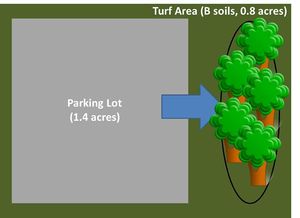
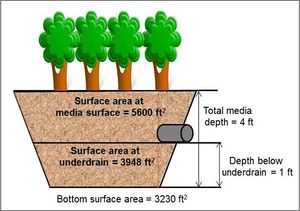
An unlined tree trench system with an elevated underdrain is to be constructed in a watershed that contains a 1.4 acre parking lot surrounded by 0.8 acres of pervious area (turf area and the tree trench BMP area). All of the runoff from the watershed will be treated by the tree trench system. The soils across the area have a unified soils classification of SM (HSG type B soil). The surface area of the tree trench basin is 5600 square feet at the media surface. The surface area at the invert of the underdrain will be 3948 square feet. The area at the media-soil interface is 3320 square feet. The total media depth will be 4 feet with 1 foot of media between the underdrain and native soils. Following the MPCA Construction Stormwater General Permit requirement, the water in the media of the tree trench needs to drawdown in a 48 hour time period. The media will be Media Mix D, which is a loamy sand composition resulting in a difference between the media wilting point and field capacity of 0.05 cubic feet per cubic foot and a difference between the media porosity and field capacity of 0.35 cubic feet per cubic foot. The tree trench will be planted with 10 medium sized deciduous trees. The following steps detail how this system would be set up in the MIDS calculator.
Step 1: Determine the watershed characteristics of your entire site. For this example we have a 2.2 acre site with 1.4 acres of impervious area and 0.8 acres of pervious area in type B soils. The pervious area includes the turf area and the area of the tree trench basin.
Step 2: Fill in the site specific information into the “Site Information” tab. This includes entering a Zip Code (55414 for this example) and the watershed information from Step 1. The Managed turf area includes the turf area and the area of the tree trench basin. Zip code and impervious area must be filled in or an error message will be generated. Other fields on this screen are optional.
Step 3: Go to the Schematic tab and drag and drop the “Tree trench system/Box (with underdrain)” icon into the “Schematic Window”
- MIDS calculator screen shots. Click on an image for enlarged view.
Step 4: Open the BMP properties for the tree trench by right clicking on the “Tree trench system/Box (with underdrain)” icon and selecting “Edit BMP properties”, or by double clicking on the “Tree trench system/Box (with underdrain)” icon.
Step 5: Click on the “Minnesota Stormwater Manual Wiki” link or the “Help” button to review input parameter specifications and calculation specific to the “Tree trench system/Box (with underdrain)” BMP.
Step 6: Determine the watershed characteristics for the tree trench. For this example the entire site is draining to the tree trench. The watershed parameters therefore include a 2.2 acre site with 1.4 acres of impervious area and 0.8 acres of pervious turf area in type B soils. There is no routing for this BMP. Fill in the BMP specific watershed information (1.4 acres on impervious cover and 0.8 acres of Managed turf in B soils).
Step 7: Enter in the BMP design parameters into the “BMP parameters” tab. Tree trench system with an underdrain requires the following entries.
- Is the underdrain elevated above native soils – Yes;
- Are the sides of the basin lined with an impermeable liner – No;
- Is the bottom of the basin lined with an impermeable liner – No;
- Surface area at media surface which is 5600 square feet;
- Surface area at underdrain which is 3948 square feet;
- Bottom surface area (area at media-soil interface) which is 3230 square feet;
- Total media depth which is 4 feet;
- Depth below underdrain which is 1 foot;
- Media field capacity minus wilting point which is 0.05 cubic feet per cubic foot;
- Media porosity minus field capacity which is 0.35 cubic feet per cubic foot;
- Tree type is Deciduous;
- Tree Size is Medium;
- Number of Trees is 10;
- Planting media mix which is Media Mix D;
- Is the P content of the media less than 30 mg/kg which autofills to “Yes” for Media Mix D;
- Is there a designed phosphorus treatment layer – No;
- Underlying soil – Hydrologic Soil Group which is SM (HSG B; 0.45 in/hr) from the dropdown box; and
- Required drawdown time (hrs) which is 48 from the dropdown box.
Step 8:Click on “BMP Summary” tab to view results for this BMP.
Step 9: Click on the “OK” button to exit the BMP properties screen.
Step 10: Click on “Results” tab to see overall results for the site.
Requirements

- 3 foot separation from the bottom of the tree system to the seasonal high water table
- Use the most restrictive infiltration rate within 5 feet of the bottom of the BMP
- For measured infiltration rates, apply a safety factor of 2
- Pretreatment
Recommendations
- Drawdown time of 24 hours when the discharge is to trout streams
- Field tested infiltration rates rather than table values
Information
- Guidance on determining infiltration rates
- Information on site constraints (shallow soil, karst, etc.)
- Guidance on pretreatment
- Information on soil mixes
- Plant information, including species list that show water tolerance, potential effects of different species on infiltration rates, planting guidance
- Construction specifications
- Information on operation and maintenance of bioretention BMPs.
Links to MIDS pages
- Overview of Minimal Impact Design Standards (MIDS)
- Performance goals for new development, re-development and linear projects
- Design Sequence Flowchart-Flexible treatment options
- Community Assistance Package
- MIDS calculator
- Performance curves for MIDS calculator
- Training and workshop materials and modules
- Technical documents
Related pages
- Overview for trees
- Types of tree BMPs
- Plant lists for trees
- Street sweeping for trees
- References for trees
- Supporting material for trees
The following pages address incorporation of trees into stormwater management under paved surfaces
- Design guidelines for tree quality and planting - tree trenches and tree boxes
- Design guidelines for soil characteristics - tree trenches and tree boxes
- Construction guidelines for tree trenches and tree boxes
- Protection of existing trees on construction sites
- Operation and maintenance of tree trenches and tree boxes
- Assessing the performance of tree trenches and tree boxes
- Calculating credits for tree trenches and tree boxes
- Case studies for tree trenches and tree boxes
- Soil amendments to enhance phosphorus sorption
- Fact sheet for tree trenches and tree boxes
- Requirements, recommendations and information for using trees as a BMP in the MIDS calculator
- Requirements, recommendations and information for using trees with an underdrain as a BMP in the MIDS calculator

